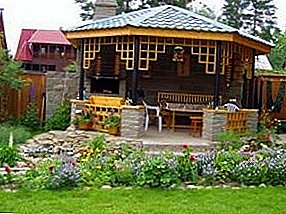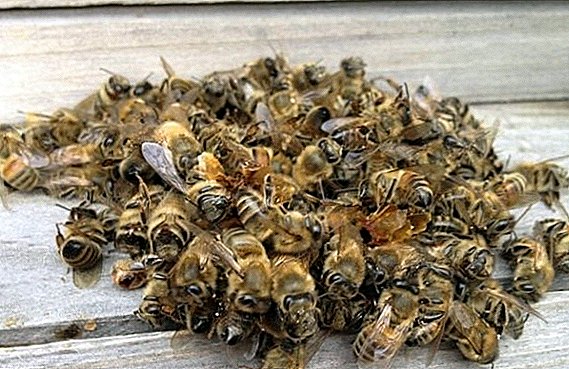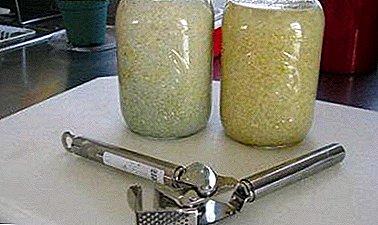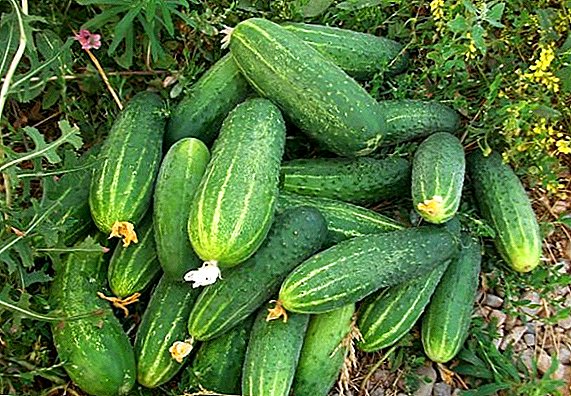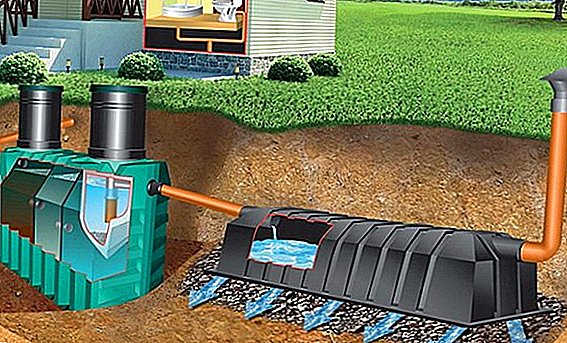 Dacha plots and private households are often located in places remote from the central sewage system, so an important task for their owners is to ensure proper disposal of wastewater in compliance with sanitary standards. Familiar to all cesspool does not meet these requirements, so this problem is solved by installing septic tanks, which will be discussed.
Dacha plots and private households are often located in places remote from the central sewage system, so an important task for their owners is to ensure proper disposal of wastewater in compliance with sanitary standards. Familiar to all cesspool does not meet these requirements, so this problem is solved by installing septic tanks, which will be discussed.
Operating principle
Septic tanks are structures representing reservoirs for accumulation of wastewater and their subsequent treatment. In the people they are often called "settlers."  The septic tank is located in a trench specially dug for it and is connected to the sewage system of the house so that the wastewater flows into its reservoir. From above, the construction is closed with a roof or a flooring with the removal of a pipe for discharge of gases generated in the septic tank.
The septic tank is located in a trench specially dug for it and is connected to the sewage system of the house so that the wastewater flows into its reservoir. From above, the construction is closed with a roof or a flooring with the removal of a pipe for discharge of gases generated in the septic tank.
The principle of operation of the structure depends on its type: some constructions assume only the accumulation of sewage with subsequent pumping out, which is performed by the waste disposal service, others convert waste, bringing already purified water into the soil.
Did you know? Discovered during excavations in the ancient Indian city of Mohenjo-Daro, the sewage system is recognized as the oldest in the world. It was built around 2600 BC. er and included baths for ritual ablutions and a city sewer system with toilets and septic tanks.
Types
There are different types of septic tanks differing in the principles of work and cleaning. 
Autonomous products with power supply
The basis of such a system is the recycling of waste due to the life activity of microflora developing in the reservoir. In order to ensure optimal habitat and bacteria, it is necessary to organize a constant supply of oxygen.
For these purposes, a compressor and additional aeration devices are used.
Such a mechanism contributes to effective wastewater treatment, removes purified water into the soil, exhaust air with gases into the ventilation duct, and insoluble sediment settles at the bottom of the corresponding structural compartment until further purification. 
Anaerobic products
This type of septic tanks is most often found in summer cottages, since it costs significantly less and is excellent for occasional, seasonal use.
The principle of operation is similar to the functioning of the previous device, with the only difference being that anaerobic bacteria are involved in the process of decomposing wastes, that is, those that do not need oxygen for life.
For the construction of the dacha, it will be useful for you to learn how to install a flowing water heater with your own hands, how to install a socket and a switch, how to make a water supply from a well into a house, how to properly glue wallpapers, how to insulate a window, how to remove old paint, how to cover a roof with indian, how to make a roof attic.
The cleaning process does not differ from an autonomous tank with power supply: water purification, sedimentation.
In anaerobic septic tanks, there are 2 types, depending on the method of cleaning the tank. 
Accumulative
The septic tank with mechanical pumping is quite primitive in design and small in size, which is good for a small area with a small amount of water use.
The cleaning principle of this construction is the same as that of an ordinary drain pit: the waste accumulates inside, when the tank is filled, the ashenisation service is called and pumped them out.
The advantage of the device is that it is sealed and does not allow polluted water to enter the soil. 
Mechanical cleaning
A septic tank with mechanical cleaning allows you to do without pumping waste with the help of vacuum trucks. Such a septic tank operates according to the principle of an ordinary filter: several consecutive sections enter into the design through which the wastewater passes, gradually being purified and forming sediment in the tanks.
Such waters at the final stage of treatment can be disposed of in the ground without risk of damage to the environment. 
Ready models
Fortunately and the relief of many owners of sites that are not supplied with central sewage, it is not necessary now to construct septic tanks on their own.
If you have a financial opportunity, you can purchase ready-to-install devices:
- Very popular among summer residents is a line of septic tanks with soil tertiary treatment of the manufacturer "Triton Plastic" with a promising name "Tank". Distinctive features of this brand are high-strength plastic case, a simple design and a wide selection of options for any wallet and needs. In addition, the manufacturer offers options for products with a stacked case to increase the volume of the tank. Since it has a very high level of purification, it will be necessary to remove sediment from the tank more often than in simpler brands.

- Autonomous sewage on power supply "Bio-S" it is intended for country sites. The distinctive features of such a septic tank - durable plastic and lightness of design, and the shape of the tank allows it to withstand a large load. In addition, the septic tank is completely sealed and can be installed in any soil, regardless of the groundwater level, and in the event of a power outage is able to cope with the task due to the multi-stage system of sedimentation. From the minuses of such a product it is possible to single out its high cost and, albeit minimal, the cost of electricity.

- Septic company "Biofor" operates independently of electricity due to the functioning of the wastewater filtration system. Its absence on the tank of welds is distinguished, which makes the design more durable, capacious tank and non-volatility. The downside is the tangible cost models.

- Septic tank "Yunilos" It is a representative of volatile septic tanks, made of durable thick-walled plastic, and its degree of water purification reaches 95%. It has a long service life - up to 50 years. The disadvantages are the large weight of the tank and power consumption, due to the presence of a powerful compressor.

Important! Purchase only branded factory-made products, as they are made of high-quality and durable plastic, which ensures the safety of their use.
Do it yourself
If you do not have extra funds to buy a finished septic tank, but you know how it works, and have basic engineering knowledge, you can try to build a sump yourself. Consider the most popular types of such products.
Learn how to do your own hands for the suburban area concrete paths, decorative waterfall, garden swing, stone grill, rose garden, flower bed, rock arias, dry stream, trellis, flower beds of tires, gabions.
Of tires
Used automobile tires can be an excellent basis for a future system. Sewerage will consist of 2 tanks, the walls of which are built of tires (5-7 tires are usually used).
Vessels will communicate among themselves similarly to the factory tank. Sewage will come to the first tank and undergo, in fact, the first stage of purification - settling with sedimentation of large parts of the waste to the bottom.
Watch a video on how to make a tire septic tank yourself.
Then, reaching the level of overflow, the purified water will flow into the second section, larger in size. In her work in a hurry to turn on the bacteria for further cleaning runoff.
The advantages of this option are relatively low cost, simplicity and high speed construction of the structure.
Undoubtedly, there are downsides:
- poor tightness of the walls, which may entail the ingress of sewage into the soil;
- usually a small tank that can withstand a very limited amount of waste;
- Such a septic tank is better suited for giving, where there is no constant and large water consumption.
Concrete rings
It is often practiced to build a settling tank of concrete rings on its own. For the construction of an optimal cleaning system, 9 concrete rings, 3 dug wells and 3 sewer manholes will be needed, which will subsequently be covered with lids.
Septic from concrete rings do it yourself: video
Wells are dug in 1 row, slightly larger in diameter than the diameter of the rings. At the bottom of the first 2 wells, a pad of concrete is poured in and the rings are mounted using a crane, the joints are filled with liquid glass, and sewer pipes are brought.
The bottom of the third well, which will receive the purified water, is covered with gravel.
Important! The first 2 wells must be airtight so that the wastewater does not infect the soil.
The advantages of this method are that such a septic tank works by fermenting waste using aerobic and anaerobic bacteria:
- such a septic tank does not require electricity costs and additional filters;
- low cost of raw materials and rapid construction;
- large volume of tanks.

Cons consist in large dimensions of the rings:
- difficult to deliver material to the site;
- special equipment required for system installation;
- Installation is possible only on large areas and will not work for small areas.
Stone or brick walls
The construction of septic tanks from bricks is more common than from concrete rings, since the work on their construction is much simpler. The most commonly used single-chamber or two-chamber type of construction. As a rule, such tanks are designed for a small amount of flow.
You may also be interested to know how to make a wicker fence, a fence of gabions, a fence from a chain-link mesh, a fence made of a picket fence.
The construction consists in preparing pits according to the number of construction chambers, at the bottom of which a cushion of sand about 30 cm thick is made.
The shape of the pit can be both cylindrical and rectangular, but the simplest option is considered to be rectangular, since it is enough to dig one pit and, when laying the walls, to build a partition between brick chambers.
Watch a video on how to make a brick septic tank with your own hands.
It is best to use clinker clay brick. The wall thickness should be at least 25 cm for a round well and at least 12 cm for rectangular masonry.
The outer perimeter of the wall is covered with clay to ensure better tightness. To lined the wall was sealed, it is rubbed with cement mortar.
Brick or stone laying on cement mortar is traditionally used; it provides good tightness and an additional construction hitch.
There is also the technology of dry masonry, that is laying the wall without using a mortar. In this case, the structure retains its strength due to its own weight and compression of elements.  This method of laying is considered to be earthquake-resistant, since the design retains flexibility and does not give cracks during shrinkage, in addition, it is very easy to dismantle if necessary.
This method of laying is considered to be earthquake-resistant, since the design retains flexibility and does not give cracks during shrinkage, in addition, it is very easy to dismantle if necessary.
The disadvantages of the construction of a stone or brick settler are weak tightness and large time costs for construction.
Plastic Eurocubes
Many people use plastic eurocubes for building a septic tank in the country.
Initially, Eurocubes are containers made of durable plastic in a steel crate, designed for transporting liquids. Often they are purchased by summer residents for storing a stock of water.  Such a vessel is very convenient to use as a sump in small areas with a small amount of wastewater. For the installation of the cube, dig the corresponding hole, where the vessel is placed.
Such a vessel is very convenient to use as a sump in small areas with a small amount of wastewater. For the installation of the cube, dig the corresponding hole, where the vessel is placed.
The advantages of such a device are cheap, easy installation, durability and tightness.
The downside is the lightness of the cube, because of what it can float, and the relatively thin material of manufacture, which under the pressure of the layer of soil can change shape.
Septic tank
To avoid unpleasant consequences in the form of soil contamination or flooding the site with sewage, it is important to correctly calculate the volume of the reservoir.
There is no difficulty in this matter: there are sanitary standards that specify the optimal capacity of the septic tank, calculated on the basis of the number of people living and the average daily rate of wastewater, taking into account the three-day supply.  Thus, 200 liters of wastewater per day is considered the norm per person, respectively, for a family of 3 people, taking into account a three-day supply, a 1.8-cubic-meter septic tank is optimally suited. m
Thus, 200 liters of wastewater per day is considered the norm per person, respectively, for a family of 3 people, taking into account a three-day supply, a 1.8-cubic-meter septic tank is optimally suited. m
In practice, many install smaller septic tanks in order to save space and money, but do not forget that we are talking about the safety of your site, so the savings in this case is inappropriate.
Soil and its influence on the choice
In order to avoid problems when installing and further using a septic tank, it is necessary to take into account the peculiarities of the soil in which it is to be placed:
- First of all, the level of groundwater at the site is estimated, and depending on this, the depth of the reservoir is selected. If the groundwater is close to the surface, additional waterproofing may be required.
- Lush soil with a predominance of sand is the best option for the installation of the tank will not require any special preparatory steps.
- The soil, in which clayey rocks predominate, practically does not absorb moisture, therefore, in this case, it is better to stop the choice on hermetic anaerobic septic tanks of accumulative type with subsequent pumping out by an ashenizator service.

Did you know? Prior to the mechanization of the process, the vacuum trucks worked manually, so they were allowed to perform this unpleasant work only at night. Waste was used as a fertilizer, and the people called it "night gold". It is for this reason that nightmen are called goldenrods.
So, we learned what a septic tank is and figured out the varieties of this device, the mechanism of action, and the installation features at the dacha. It can be concluded that even with the remoteness of your summer house from the city sewage system, it would not be difficult to properly organize the disposal of waste using such a structure.
Feedback from network users
Caissons, they are called extension hatches. It is needed if the septic tank is buried deeper than the standard depth.




